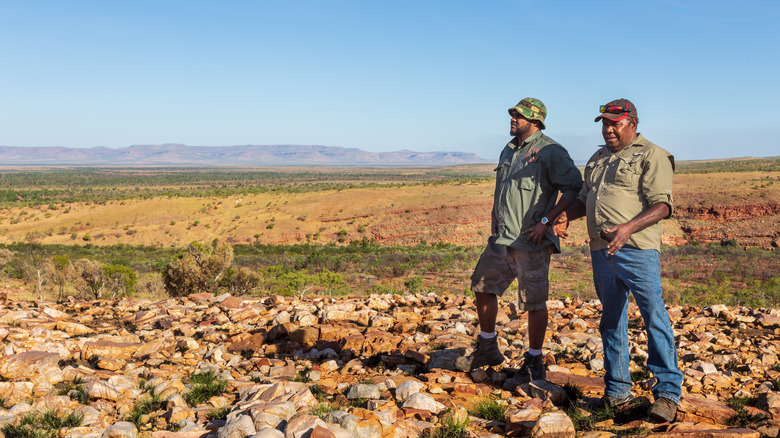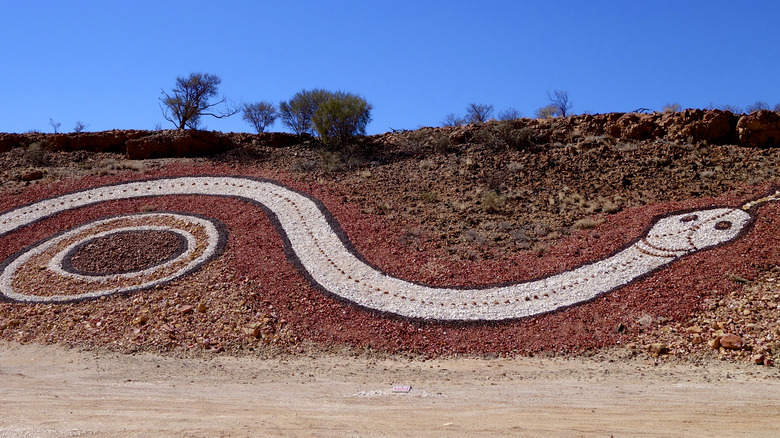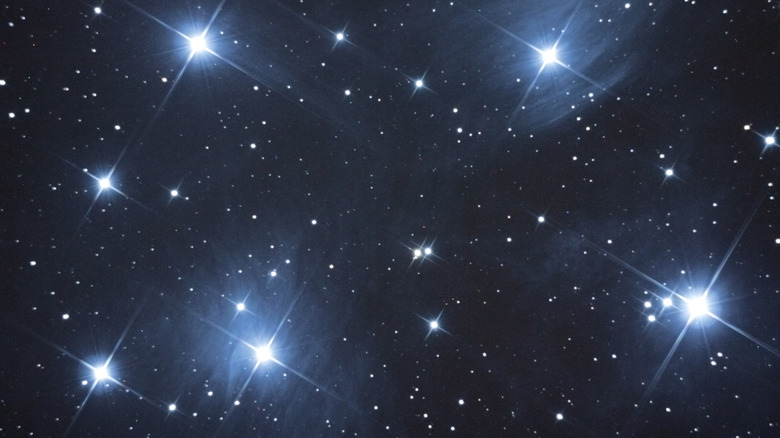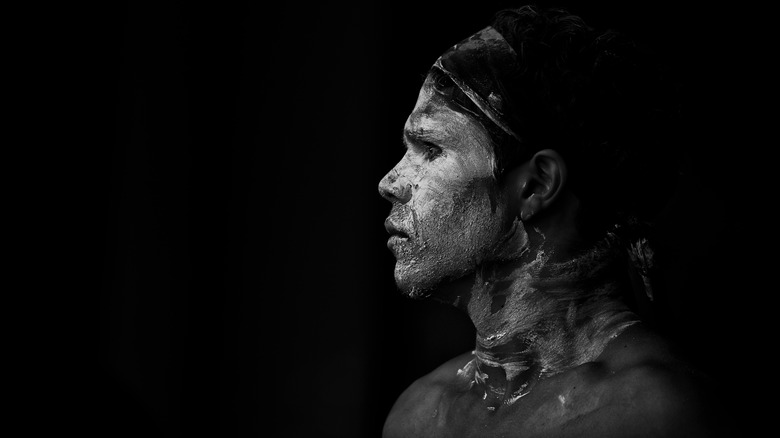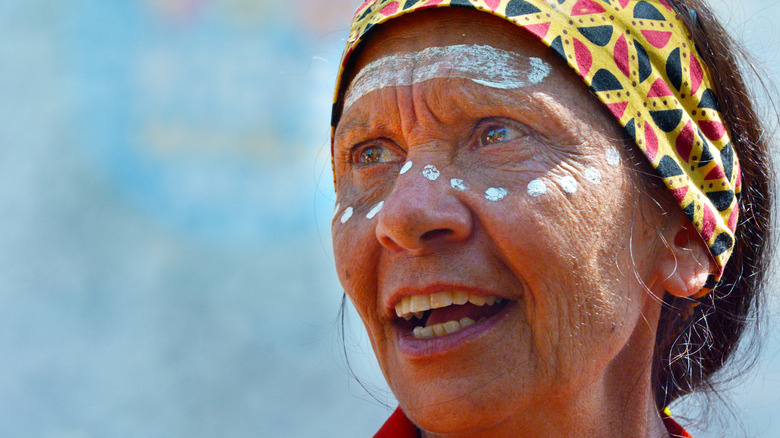The Unique System Indigenous Australians Use For Navigations
The Indigenous people of Australia have maintained their culture in the same place for longer than any other human group, according to Australia's ABC News. That has given them more than 50,000 years as a culture to get to know the landscape very well (via The Guardian). This knowledge is reflected in the tradition of "songlines." Songlines are a sort of oral map that record natural and cultural history for future generations. Several important highways in Australia — including the crossing from the Nullarbor between Perth and Adelaide and the highway between the Kimberleys and Darwin — originated as songlines, according to Common Ground.
"Songlines are known as navigational tracks, in that the elders or the trained Indigenous people will sing the landscape and therefore be able to move from location to location through it, and teach each other,' Monash University researcher Lynne Kelly told ABC News. Elders will stop at different landmarks along a songline to perform sung rituals that preserve information about the land and the journey.
Songlines aren't just about direction, however. They include both creation myths and contemporary history as well as information that helps Indigenous people survive. For example, as much as 70% of the material in Indigenous songs provides knowledge about plants, animals, and the seasons.
Songlines and the Dreamtime
While "songlines" is now the most popular term for these tracks, it is actually the term used by European settlers, according to The New York Times. Indigenous terms include ”Footprints of the Ancestors” or the ”Way of the Law.” Other names are "tjuringa line" or "dreaming track," according to novelist and biographer Nicholas Shakespeare. This last name reflects the relationship between songlines and the Indigenous Australian concepts of the Dreaming or Dreamtime.
Dreamtime, or Tjukurrpa or Ngarrangkarni in Indigenous languages, is the sacred time when the ancestors created the world, according to the gallery Japingka Aboriginal Art. During the Dreamtime, the ancestors created all of the plants, animals, and landmarks familiar to Indigenous Australians, as well as the people themselves.
However, the Dreamtime is not considered to be solely in the past. Instead, it is an ongoing process that connects contemporary Indigenous Australians to their ancestors. These ancestors journeyed across Australia as they created, and these journeys are recorded as songlines. Further, the songlines preserve the importance of certain locations along the journey and the acts of creation that occurred there. Songlines also act as a way to connect different Indigenous cultures. Each language group would be responsible for a particular portion of land and for maintaining its songlines, which would then be continued by the neighboring group in distinct chapters.
Why 'Songlines?'
So why is songlines the term most popularly used to describe this phenomenon? Japingka Aboriginal Art says that the term likely comes from the fact that the oral culture of the Indigenous Australians meant that they memorized these creation stories and journeys as long song cycles. However, the reason the term is so widespread is because author Bruce Chatwin used it as the title of his book inspired by this tradition, according to Common Ground.
Chatwin was an English travel writer who wrote "The Songlines" based on two trips he made to Australia, according to his biographer Nicholas Shakespeare. During his trip, he spent three nights traveling with Anatoly Sawenko — a man hired to map sacred Indigenous sites that might be in the way of a new railway — and a group of Indigenous Australians. He was also inspired by the work of late anthropologist Theodore Strehlow, who had written "Songs of Central Australia."
In the 1987 book, Chatwin described the songlines in very poetic language that emphasized their relationship to music. "The melodic contour of the song describes the land over which the song passes ... certain phrases, certain combinations of musical notes, are thought to describe the actions of the ancestors' feet," he wrote (via The Guardian). However, the term has been criticized somewhat for suggesting "that First Nations people would sing their way across the country like some kind of ancient GPS or map," according to Common Ground.
Australia's Odyssey
While songlines do outline the physical contours of Australia, they do so in a complex and not always linear way, Common Ground explained. In addition, they are myths and stories as much as maps. Author Noel Pearson has compared them to other foundational myths like "The Odyssey," "The Iliad," and the "Book of Genesis." Margot Neale, who serves as the head of the National Museum Australia's Indigenous Knowledges Curatorial Center, has argued that they serve as a parallel but equally important history of Australia. "The Songlines shouldn't be just an anthropological footnote, but a part of Australian history as it is taught in schools," she said (via Common Ground).
One of the oldest and most famous songline narratives is told in the Songlines of the Seven Sisters. These songlines tell the story of seven sisters who are chased across Australia by a malevolent shape-shifting spirit named Yurlu or Wati Nyiru. Eventually, the spirit chases the sisters up into the night sky, where they become the Pleiades. These songlines begin in Roeburn in the west of Australia and end along its eastern coast. In the process, they cross three different deserts and are sung by the Martu, the Anangu, Yankunytjatjara, Pitjantjatjara, and Ngaanyatjarra people, per Common Ground.
Mnemonic devices
The mythical aspect of songlines doesn't take away from their practical uses. They do act as mnemonic devices that transmit knowledge not just about how to navigate the Australian landscape but also how to survive in it. "Songlines link positions in landscape," Monash University researcher Lynne Kelly told ABC News. "Each location in the landscape acts as a memory aid to a particular part of the information system, so the knowledge is literally grounded in the landscape."
Indigenous Australians also use other memory aids like message sticks when performing the songs. There is evidence that songlines record landscape changes from 7,000 years ago.
The effectiveness of this strategy has been backed up by science. The 2014 Nobel Prize for Medicine revealed that spatial awareness and memory are linked together in the hippocampus. The prize was awarded to John O'Keefe for discovering place cells in the hippocampus that preserve spatial memory and to May-Britt Moser and Edvard I. Moser for discovering grid cells that create an internal navigation system in the nearby medial entorhinal cortex. However, these breakthroughs merely confirmed what many Indigenous cultures have long known in practice.
Songlines today
Many Indigenous cultures still know and perform songlines, especially in central and northern Australia, according to Japingka Aboriginal Art. This means that songlines are preserved for nearly 50% of the Australian continent. In places that have been settled by Europeans for more than 200 years, particularly in the South, many songlines have been forgotten, though there have been attempts to recover them.
Songlines are also an important argument for honoring Indigenous land rights. "It's quite complex, but those land markers are very, very important, hence the importance of land claims and acknowledgment of traditional owners," Karen Adams, an associate professor in medicine and health sciences at Monash University and a Wiradjuri woman, told ABC News. They have been used to legally prove that Indigenous Australians have title to certain lands under both the Aboriginal Land Rights Act of 1976 and the Native Title Act of 1993, according to "Songlines and Land Claims: Space and Place" by Noelle Higgins.
